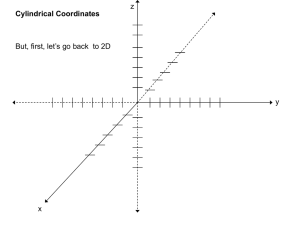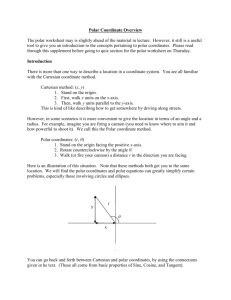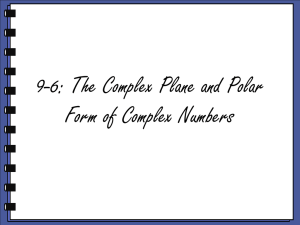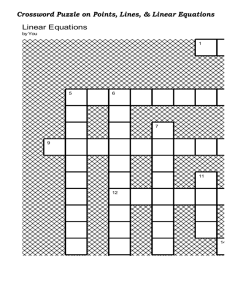Polar Coordinate System
advertisement
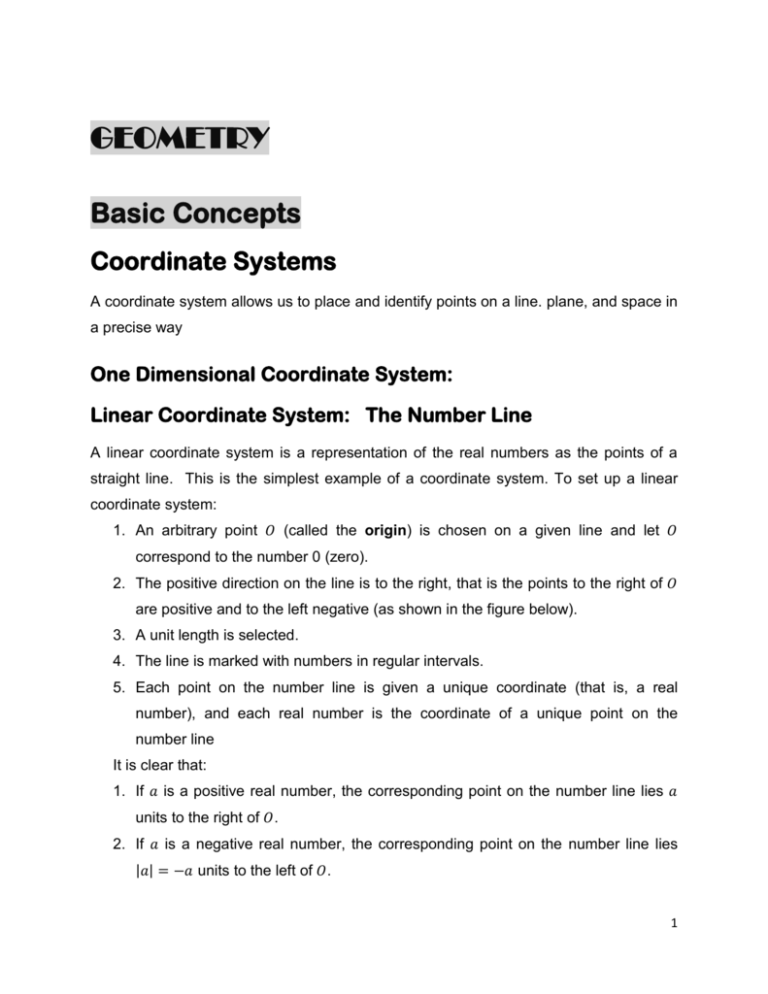
GEOMETRY Basic Concepts Coordinate Systems A coordinate system allows us to place and identify points on a line. plane, and space in a precise way One Dimensional Coordinate System: Linear Coordinate System: The Number Line A linear coordinate system is a representation of the real numbers as the points of a straight line. This is the simplest example of a coordinate system. To set up a linear coordinate system: 1. An arbitrary point 𝑂 (called the origin) is chosen on a given line and let 𝑂 correspond to the number 0 (zero). 2. The positive direction on the line is to the right, that is the points to the right of 𝑂 are positive and to the left negative (as shown in the figure below). 3. A unit length is selected. 4. The line is marked with numbers in regular intervals. 5. Each point on the number line is given a unique coordinate (that is, a real number), and each real number is the coordinate of a unique point on the number line It is clear that: 1. If 𝑎 is a positive real number, the corresponding point on the number line lies 𝑎 units to the right of 𝑂. 2. If 𝑎 is a negative real number, the corresponding point on the number line lies |𝑎| = −𝑎 units to the left of 𝑂. 1 In other words, the coordinate of a point P is the distance of P from 𝑂 together with positive or negative sign depending on which side of 𝑂 the point P lies. Distance Formula: If 𝑃1 and 𝑃2 are two points with coordinates 𝑥1 and 𝑥2 on the real line, then their distance |𝑃1 𝑃2 | is defined by |𝑃1 𝑃2 | = |𝑥2 − 𝑥1 | Example: If 𝑃1 and 𝑃2 are two points with coordinates 𝑥1 = 5 and 𝑥2 = −2 on the real line, then their distance |𝑃1 𝑃2 | is |𝑃1 𝑃2 | = |𝑥2 − 𝑥1 | = |−2 − 5| = |−7| = 7 Two Dimensional Coordinate System: The Plane A two dimensional coordinate system allows us to place a point on a plane in a precise way. Out of the several two dimensional coordinate systems for addressing points in the plane we discuss two most beneficial and widely used systems. These are: 1. Rectangular coordinate system (also known as Cartesian coordinate system) 2. Polar coordinate system. These coordinate systems provide us two different methods of using two numbers to locate a point on a plane. Rectangular Coordinate System or Cartesian Coordinate System: A rectangular coordinate system or the coordinate plane is a representation of ordered pairs of real numbers as the points of a plane. In this system, every point in the plane can be specified uniquely by an ordered pair of real numbers, and every ordered pair of real numbers represents a unique point on the plane. 2 To set up a rectangular coordinate system in a plane: 1. We choose a pair of lines, called axes or coordinate lines; one horizontal and one vertical. The two axes are perpendicular to each other. The horizontal axis is called the x-axis, and the vertical one called the y-axis. 2. We set linear coordinate systems on the axes satisfying the following conditions: i. The origin of each linear coordinate system on the x-axis (that is the horizontal coordinate line), and the y-axis (that is the vertical coordinate line) is the point of intersection 𝑂 of x-axis and y-axis. ii. For the x-axis the positive direction is to the right, that is the points to the right of 𝑂 are positive and to the left negative. For the y-axis the positive direction is upward, that is the points above the origin are positive, below negative. An ordered pair of real numbers 𝑎 and 𝑏, written as (𝑎, 𝑏), represents a point on the plane. 𝑎 is called 𝒙-coordinate and 𝑏 is called 𝒚-coordinate of the point. Notation: A point 𝑃 with coordinates (𝑎, 𝑏) is denoted by 𝑃(𝑎, 𝑏). In order to locate the point (𝑎, 𝑏) on the plane, let there be a vertical line passing through 𝑎 on the x-axis (that is the line 𝑥 = 𝑎 ), and a horizontal line passing through 𝑏 on the y-axis (that is the line 𝑦 = 𝑏 ). The intersection of these two lines is the point (𝑎, 𝑏). Example: The points (0,0), (2,3), (−3,1) and (−1.5, −2.5) are located on a coordinate plane. 3 Distance Formula: (Cartesian Coordinates) Recall Pythagoras Theorem. For a right-angled triangle the hypotenuse length c is given by 𝑐 = √𝑎 2 + 𝑏 2 We use this to find the distance between any two points 𝑃1 (𝑥1 , 𝑦1 ) and 𝑃2 (𝑥2 , 𝑦2 ) on the Cartesian plane. We see that: 1. The point (𝑥2 , 𝑦1 ) is at the right angle. 2. The distance between the points 𝑃1 (𝑥1 , 𝑦1 ) and 𝑃3 (𝑥2 , 𝑦1 ) is |𝑥2 − 𝑥1 |. In this it is 𝑥2 − 𝑥1 . 3. The distance between the points 𝑃3 (𝑥2 , 𝑦1 ) and 𝑃2 (𝑥2 , 𝑦2 ) is |𝑦2 − 𝑦1 |. In this case it is 𝑦2 − 𝑦1 . Using Pythagoras' theorem the distance between the points 𝑃1 (𝑥1 , 𝑦1 ) and 𝑃2 (𝑥2 , 𝑦2 ) is given by: 𝑑 = √(𝑥2 − 𝑥1 )2 + (𝑦2 − 𝑦1 )2 4 Example : Find the distance between the points (3, −4) and (5,7) Here, 𝑥1 = 3 and 𝑦1 = −4 , 𝑥2 = 5 and 𝑦2 = 7. So the distance is given by: 𝑑 = √(𝑥2 − 𝑥1 )2 + (𝑦2 − 𝑦1 )2 = √(5 − 3)2 + (7 − (−4))2 = √22 + 112 = √4 + 121 = √125 ≈ 11.18 Polar Coordinate System: Another common coordinate system for the plane is the Polar coordinate system This is a two-dimensional coordinate system in which each point on a plane is determined by two numbers; an angle and a distance. In polar coordinate system: 1. A point called pole (also called origin or center) is marked on the plane. 2. A horizontal ray is drawn from this point to the right. We call this the reference ray or polar axis. A point 𝑃 in the plane is specified by an ordered pair of numbers (𝑟, 𝜃) called polar coordinates. The first coordinate 𝑟 is the distance from the point to the pole, called the radial coordinate of the point. If 𝑟 is negative, than the point is on the opposite side with respect to the pole. The second coordinate 𝜃 is the positive (counterclockwise) angle required to reach the point 𝑃 from the 0° ray (or 0 radian ray) or polar axis, called the angular coordinate (also known as the polar angle). Polar Graph 5 Important: 1. In polar coordinate, a point can have many representations. For examples: i. For r = 0, θ can be set to any real value. ii. (𝑟, 𝜃) and (𝑟, 𝜃 + 2𝜋) represent the same point. iii. (𝑟, 𝜃) and (−𝑟, 𝜃 + 𝜋) represent the same point. 2. For r ≠ 0, to get a unique representation for θ, it must be limited to an interval of size 2π. Conventional choices for such an interval are [0, 2π) and (−π, π]. 3. Angles in polar notation are generally expressed in either degrees or radians, using the conversion 2π rad = 360°. A polar grid with several angles labeled in radians is shown in the following figure. Example: The point (4, 50° ) is plotted stepwise on the polar plane. Step 1: Measure 4 units from pole along polar axis. 6 Step 2: Rotate by an angle of 50° in the counterclockwise direction. Example: Locate the pont (2, 3π/4) n polar coordinate system. In the following example, we use polar graph paper for plotting points given in polar coordinates. Example: Plot the points (2, 60°), (4, 165°) and (3, 315°) on the following polar grid: 7 Converting between Polar and Cartesian Coordinates: The conversion between polar Coordinates (𝑟, 𝜃) and rectangular coordinates (𝑥, 𝑦) can be understood by observing the following right triangle and using Pythagoras theorem. Converting Polar Coordinates to Cartesian Coordinates: The two polar coordinates r and θ can be converted to the Cartesian coordinates x and y by using the trigonometric functions sine and cosine: Converting Cartesian Coordinates to Polar Coordinates: Two Cartesian coordinates x and y can be converted to polar coordinates 𝑟 and 𝜃 by 𝑟 = √𝑥 2 + 𝑦 2 (by a simple application of the Pythagoras theorem) 𝑦 𝜃 = tan−1 𝑥 (tan−1 is sometimes written as arctan) To determine a unique value of the angular coordinate θ (when 𝑟 ≠ 0), it must be limited to an interval of size 2π. Such an interval can be [0, 2π) or (−π, π]. To obtain θ in the interval [0, 2π), some important facts about rectangular coordinates 𝑥 and 𝑦 in each of the four quadrants, and the polar coordinate 𝜃 may 8 be noted: See the table: First Quadrant 𝑥 > 0, 𝑦 ≥ 0 2nd Quadrant 3rd Quadrant 4th Quadrant 0≤𝜃< 𝜋 2 𝜋 <𝜃≤𝜋 2 3𝜋 𝑥 < 0, 𝑦 < 0 𝜋 < 𝜃 < 2 3𝜋 𝑥 > 0, 𝑦 < 0 < 𝜃 < 2𝜋 2 𝑥 < 0, 𝑦 ≥ 0 𝑦 𝜋 < 𝑥 2 𝜋 𝑦 < tan−1 ≤ 𝜋 2 𝑥 𝑦 𝜋 0 < tan−1 < 𝑥 2 𝜋 𝑦 < tan−1 < 𝜋 2 𝑥 0 ≤ tan−1 𝑦 +𝜋 𝑥 𝑦 𝜃 = tan−1 + 𝜋 𝑥 𝜃 = tan−1 Example: (Converting from Polar to Cartesian) What is (13, 23 °) in Cartesian coordinates? Here angle is measured in degrees. We have a point in polar coordinates (r, θ), and need it in Cartesian coordinates(𝑥, 𝑦). We solve the triangle for x and y: We have 𝑟 = 13 𝜃 = 23° 𝑥 = 𝑟 cos 𝜃 = 13 cos 23° 𝑦 = 𝑟 sin 𝜃 = 13 sin 23° (𝑥, 𝑦) = (13 cos 23° , 13 sin 23° ) Example: (Converting from Polar to Cartesian) What is (−4, 𝜋⁄3) in Cartesian coordinates? Here angle is measured in radians. 9 Here 𝜃 = 𝜋⁄3 𝑟 = −4 Therefore 𝑥 = 𝑟 cos 𝜃 = −4 cos 𝜋⁄3 = −4 × 1 = −2 2 𝑦 = 𝑟 sin 𝜃 = 𝑟 sin 𝜃 13 sin 𝜋⁄3 = = −4 × √3 = −2 √3 2 (𝑥, 𝑦) = (−2, −2 √3) Example: (Converting from Cartesian to Polar) What is (12,5) in Polar coordinates? We have a point in Cartesian coordinates(𝑥, 𝑦), and find its polar coordinates (r, θ). We solve the triangle for 𝑟 and 𝜃: Here 𝑥 = 12 𝑦=5 (both positive) 𝑟 = √𝑥 2 + 𝑦 2 = √122 + 52 = √144 + 25 = √169 = 13 𝜃 = tan−1 5 12 (𝑟, 𝜃) = (13, tan−1 5 ) 12 Example: (Converting from Cartesian to Polar) Convert the Cartesian coordinates (1,-1) and (-1,4) to polar coordinates. To find the polar coordinates (r, θ) of the points we solve the triangles for 𝑟 and 𝜃: 10 1. Here 𝑥 = 1 𝑦 = −1 (𝑥 > 0, 𝑦 < 0 ) 𝑟 = √𝑥 2 + 𝑦 2 = √12 + (−1)2 = √1 + 1 = √2 −1 𝜋 𝜋 7𝜋 = tan−1(−1) = − ≈ − + 2𝜋 = 1 4 4 4 7𝜋 (𝑟, 𝜃) = (√2, ) 4 𝜃 = tan−1 2. Here 𝑥 = −1 𝑦=4 (𝑥 < 0 ) 𝑟 = √𝑥 2 + 𝑦 2 = √(−1)2 + 42 = √1 + 16 = √17 𝜃 = tan−1 4 = tan−1(−4) ≈ tan−1(−4) + 𝜋 −1 (𝑟, 𝜃) = (√17, tan−1(−4) + 𝜋) Distance Formula: (Polar Coordinates) The distance between two points 𝑃1 (𝑟1 , 𝜃1 ) and 𝑃2 (𝑟2 , 𝜃2 ) is given by: 𝑑 = √𝑟1 2 + 𝑟2 2 − 2𝑟1 𝑟2 cos(𝜃2 − 𝜃1 ) Example: Find the distance between the points with polar coordinates 11 Here we have 𝜋 6 3𝜋 𝜃2 = 4 𝑟1 = 1 𝜃1 = 𝑟2 = 3 Method 1: We use direct the formula for distance between points whose polar coordinates are given. 3𝜋 𝜋 𝑑 = √𝑟1 2 + 𝑟2 2 − 2𝑟1 𝑟2 cos(𝜃2 − 𝜃1 ) = √12 + 32 − 2 × 1 × 3 cos ( − ) 4 6 = √1 + 9 − 6 (cos = √10 − 6 [− 3𝜋 𝜋 3𝜋 𝜋 √2 √3 √2 1 cos + sin sin ) = = √10 − 6 [(− ) × + × ] 4 6 4 6 2 2 2 2 √6 √2 + ]= 4 4 √40 − 6(√2 − √6) √4 √40 − 6(√2 − √6) = Method 2: 2 First we convert polar coordinates of the given points to Cartesian coordinates and then use the formula 𝑑 = √(𝑥2 − 𝑥1 )2 + (𝑦2 − 𝑦1 )2 fot distance between points whose rectangular coordinates are given. The Cartesian coordinates for the two points are 12 The distance between the two points is: Note that the distance is same in both the cases. 13 Inclination or Angle of Inclination of a Line in Plane: The inclination of a line L (or angle of inclination of L) is the angle α which the line L makes with positive direction of x-axis. Inclination 𝜶 of a line joining the two points 𝑷𝟏 (𝒙𝟏 , 𝒚𝟏 ) and 𝑷𝟐 (𝒙𝟐 , 𝒚𝟐 ) is defined by 𝑦2 − 𝑦1 tan 𝛼 = 𝑥2 − 𝑥1 Note: By definition inclination 𝛼 is between 0 and 𝜋. Example: Find the inclination of the line joining the points 𝑃1 (2, −5) and 𝑃2 (−3, −8). 𝑥1 = 2 𝑦1 = −5 𝑥2 = −3 𝑦2 = −8 So the the inclination is determined by: tan 𝛼 = 𝑦2 − 𝑦1 −8— 5 = −3−2 𝑥2 − 𝑥1 −3 − 2 −8 + 5 −3 3 = = −5 −5 5 3 𝛼 = tan−1 5 = ⇒ Slope (or Gradient): The slope of a line is defined as (vertical rise)/(horizontal run)= b/a 14 Suppose a line L is determined by two points 𝑃1 (𝑥1 , 𝑦1 ) and 𝑃2 (𝑥1 , 𝑦1 ). We see from the diagram above, that the slope is given by: 𝑦2 − 𝑦1 𝑆𝑙𝑜𝑝𝑒 = = tan 𝛼 𝑥2 − 𝑥1 Example: Find the slope of the line joining the points 𝑃1 (−4, −1) and 𝑃2 (2, −5). 15 Here 𝑥1 = −4 𝑦1 = −1 𝑥2 = 2 𝑦2 = −5 So the slope is: 𝑚= = 𝑦2 − 𝑦1 −5 − (−1) = 𝑥2 − 𝑥1 2 − (−4) −4 2 =− 6 3 Positive and Negative Slopes: A positive slope indicates the value of the dependent variable increases as we go left to right: (If x increases, then y increases.) A negative slope means that the value of the dependent variable decreases as we go left to right: (If x increases, then y decreases.) When angle of inclination 𝛼 is between 0 and 𝜋⁄2 , the slope is positive. When angle of inclination 𝛼 is between 𝜋⁄2 and 𝜋, the slope is negative. 16 Relation between Inclination and Slope: We have a line with slope m and the angle that the line makes with the x-axis is α. From the terminology tangent of angle α is given by: Now, since slope is also defined as opposite/adjacent, we have the relations: 𝑚 = tan 𝛼 𝛼 = tan−1 𝑚 Example: Find the inclination of the line with slope 2. Here, tan α = 2 So 𝛼 = tan−1 2 = 63.43° . 17 Example: Find the slope of the line with inclination α = 137°. The situation is as follows: So the slope is: m = tan α = tan 137° = -0.933 Note that the slope is negative. 18


